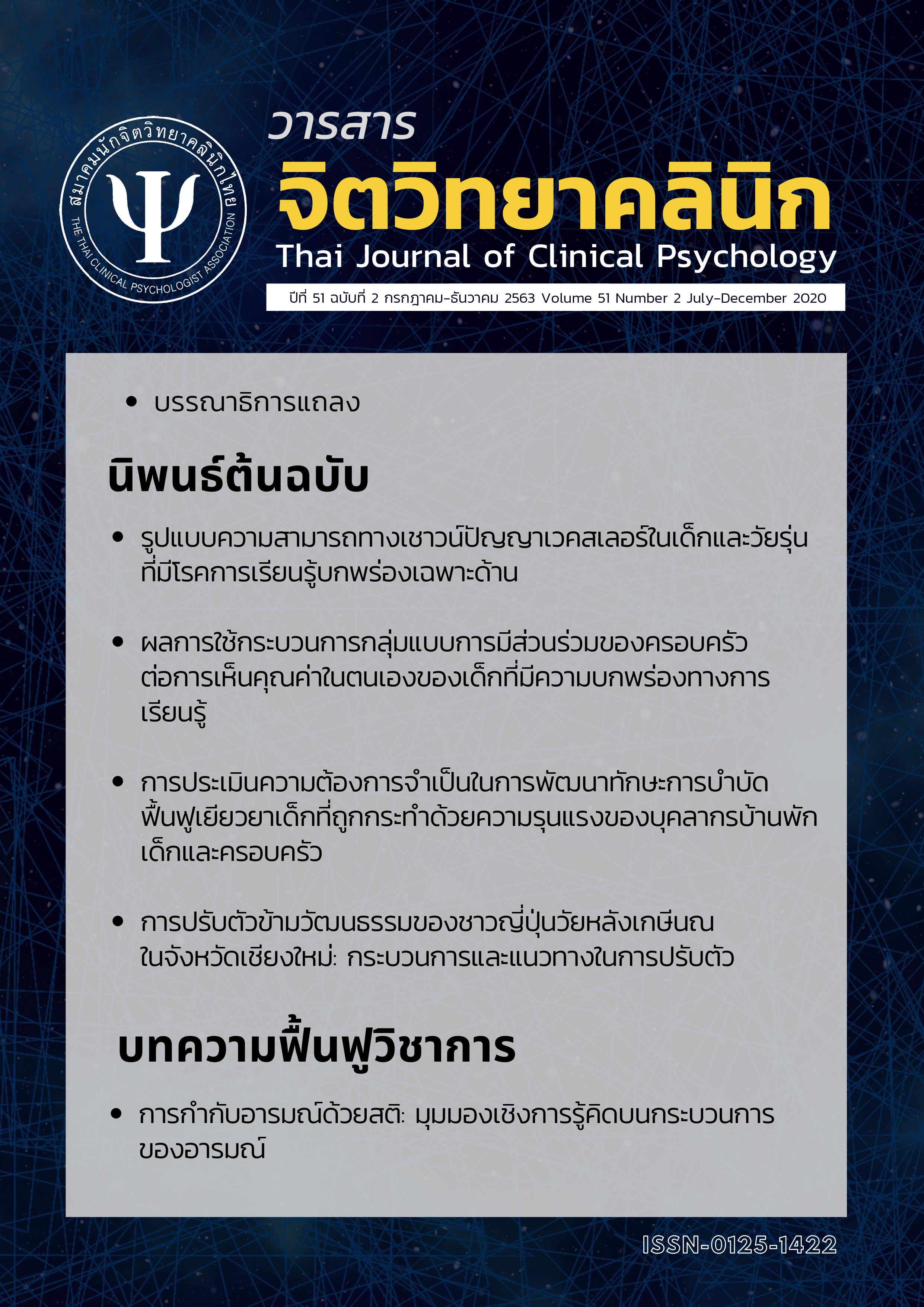รูปแบบความสามารถทางเชาวน์ปัญญาเวคสเลอร์ในเด็กและวัยรุ่นที่มีโรคการเรียนรู้บกพร่องเฉพาะด้าน
Main Article Content
บทคัดย่อ
วัตถุประสงค์ เพื่อศึกษารูปแบบของคะแนนจากแบบทดสอบความสามารถทางเชาวน์ปัญญา Wechsler Intelligence Scale for Children-Third Edition (WISC-III) ในเด็กและวัยรุ่นที่มีโรคการเรียนรู้บกพร่องเฉพาะด้าน รวมทั้งศึกษาความสัมพันธ์ระหว่างคะแนนจากแบบทดสอบย่อย WISC-III และคะแนนจากแบบทดสอบผลสัมฤทธิ์ทางการเรียน(Wide Range Achievement Test-Thai version (WRAT- Thai)
วัสดุและวิธีการ ที่ศึกษาในรูปแบบการทบทวนเวชระเบียนย้อนหลัง (Retrospective chart review) โดยรวบรวมข้อมูลจากแฟ้มเวชระเบียนเด็กและวัยรุ่นที่มีช่วงอายุ 6-17 ปี จำนวน 89 คนที่ได้รับการวินิจฉัยว่ามีโรคการเรียนรู้บกพร่องเฉพาะด้าน และมีค่าความฉลาดทางเชาวน์ปัญญาอยู่ในเกณฑ์ปกติ (Full Scale IQ ≥90) รวบรวมข้อมูลจากสาขาวิชาจิตเวชศาสตร์เด็กและวัยรุ่น โรงพยาบาลศิริราช
ผลการศึกษา จากการวิเคราะห์พบว่ารูปแบบคะแนนจากแบบทดสอบ WISC-III ที่มีความสัมพันธ์กับคะแนนจากแบบทดสอบ WRAT- Thai ได้แก่ ความสามารถทางเชาวน์ปัญญาโดยรวม (Full Scale IQ) ความสามารถทางเชาวน์ปัญญาทางภาษา (Verbal IQ) คะแนนดัชนีความสามารถด้านความเข้าใจภาษา (Verbal Comprehension Index) คะแนนดัชนีความสามารถด้านการตั้งใจและการมีสมาธิ (Freedom from Distractibility Index) และแบบทดสอบย่อย Information, Similarities และ Digit Span ซึ่งข้อค้นพบนี้แสดงให้เห็นว่า โรคการเรียนรู้บกพร่องเฉพาะด้าน
มีความสัมพันธ์กับความรู้พื้นฐานของผู้เรียน การเข้าใจคำศัพท์ ความจำ และความสนใจ
Article Details
เรื่องที่ลงตีพิมพ์ในวารสารจิตวิทยาคลินิกแล้วถือเป็นลิขสิทธิ์การเผยแพร่โดยวารสารจิตวิทยาคลินิกแต่เพียงผู้เดียว การตีพิมพ์หรือเผยแพร่ซ้ำในที่อื่นต้องได้รับอนุญาตจากกองบรรณาธิการวารสารฯ
References
American Psychiatric Association. (2013). Diagnostic And Statistical Manual Of Mental Disorders, Fifth Edition (DSM-5).
Butterworth, B., & Kovas, Y. (2013). Understanding neurocognitive developmental disorders can improve education for all. Science, 300–305.
Dulcan, M. K. (2015). Dulcan’s textbook of child and adolescent psychiatry. Wilson Boulevard Arlington: American Psychiatric Association Publishing.
Nicholson, C. L., & Alcorn, C. L. (1993). Interpretation of the WISC-III and Its Subtests. Annual Meeting of the National Association of School Psychologists (pp.1-16). Washington DC: Washington DC. Passolunghi, M. C., & Lanfranchi, S. (2012). Domain-specific and domain-general precursors of mathematical achievement: a longitudinal study from kindergarten to first grade. The British journal of educational psychology, 42–63.
Piyasil, V., & Wangtan, S. (2015). Learning Disorders and Comorbidity. Journal of the Psychiatric Association of Thailand, 287-296.
Sangsupawanich, P., Tantiwech, S., Tosanguan, K., Patana-bhaesaj, J., lekuthai, W.,Worachotekamjorn, J., & et al. (2011). Research report for screening Attention
deficit hyperactivity disorder and Learning disorder in school. Nonthaburi: Thai Health Promotion Foundation.
Sayawaranon, P. (1997). The study of Academic Achievement in Elementary school
students. Thai Journal of Clinical Psychology, 24-37.
Soongprasit, M., & Thongpuang, P. (2014). Intelligence quotient in children and
adolescents with reading disabilities. Journal of psychiatric association of Thailand, 87-96.
Svanum, S., & Bringle, R. G. (1982). Race, social class, and predictive bias: An evaluation using the WISC, WRAT, and teacher ratings. Intelligence, 275-286.
Swanson, H. L. (1993). Individual differences in working memory: A model testing and
subgroup analysis of learning-disabled and skilled readers. Intelligence, 285-332.
Swanson, H. L., Harris, K. R., & Graham, S. (2003). Handbook of learning disabilities. New York: The Guilford Press.
Unpri, P., Kaewphonsawan, T., Limsricharun, K., Phattharayuttawat, S., & Witulchart, C. (2011). Memory in children with learning disabilities. Journal of psychiatric
association of Thailand, 229-242.
Wechsler, D. (1991). Manual for the Wechsler intelligence scale for children 3rd Ed. San Antonio: Psychological corporation.

